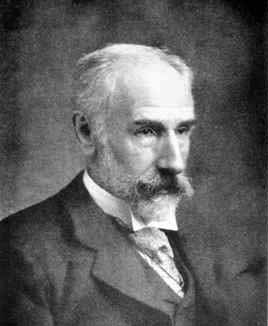Francis Ysidro Edgeworth facts for kids
Quick facts for kids
Francis Ysidro Edgeworth
|
|
|---|---|
 |
|
| Born | 8 February 1845 Edgeworthstown, County Longford, Ireland
|
| Died | 13 February 1926 (aged 81) Oxford, Oxfordshire, England
|
| Alma mater | Trinity College Dublin Balliol College, Oxford |
| Awards | Guy Medal (Gold, 1907) |
| Scientific career | |
| Fields | Philosophy, political economist |
| Signature | |
Francis Ysidro Edgeworth (born February 8, 1845 – died February 13, 1926) was an important Anglo-Irish thinker and political economist. He made big contributions to how we use statistics in the 1880s. From 1891, he was the first editor of The Economic Journal, a well-known economics magazine.
Contents
His Life and Education
Francis Ysidro Edgeworth was born in Edgeworthstown, a town in County Longford, Ireland. His father was Francis Beaufort Edgeworth, and his mother was Rosa Florentina. His famous aunt was the writer Maria Edgeworth.
Francis was the youngest of seven children. He did not go to a regular school. Instead, he was taught by private teachers at his family's home until he was old enough for university.
He studied at Trinity College Dublin and Balliol College, Oxford. He learned old and new languages. After university, he taught himself mathematics and economics. He became a barrister (a type of lawyer) in London in 1877, but he never actually worked as one.
Because of his writings on economics and mathematical statistics in the 1880s, Edgeworth became a professor. In 1888, he got a job teaching economics at King's College London. In 1891, he became the Drummond Professor of Political Economy at Oxford University. That same year, he also became the first editor of The Economic Journal. He continued to edit this journal until he died 35 years later.
The Royal Statistical Society gave him the Guy Medal in Gold in 1907 for his work in statistics. Edgeworth was also the president of the Royal Statistical Society from 1912 to 1914.
His Ideas in Economics
Edgeworth was a very important person in the growth of neo-classical economics. This is a way of thinking about how people make choices in the economy. He was the first to use special math tools to study how individuals make economic decisions.
Understanding Choices and Trade
He helped create utility theory, which is about how much satisfaction people get from things. He also came up with the indifference curve. This is a way to show different combinations of goods that give someone the same amount of happiness.
He also created the famous Edgeworth box. This is a diagram that helps students understand how two people can trade goods to make both of them better off.
Edgeworth also had an idea called the Edgeworth conjecture. This idea says that as more and more people join an economy, the possible outcomes of trading become more clear and predictable. In statistics, his name is remembered with the Edgeworth series.
His Book: Mathematical Psychics (1881)
His most creative book on economics was Mathematical Psychics: An Essay on the Application of Mathematics to the Moral Sciences. It was published in 1881.
In this book, he looked at how people trade. He showed that if people could keep making new deals, there would be many possible outcomes for a trade. This idea was later used in game theory and is called "the core". The book also showed the first example of the indifference curve.
Many people found his book hard to read. He often used quotes from literature and wrote parts in different languages like Latin, French, and Ancient Greek. The math was also very difficult.
However, other important economists saw how brilliant his ideas were. Alfred Marshall, a famous economist, said about Mathematical Psychics:
- This book shows clear signs of genius, and is a promise of great things to come... we can only admire its brilliancy, force, and originality.
His friend, William Stanley Jevons, also said:
- Whatever else readers of this book may think about it, they would probably all agree that it is a very remarkable one.... There can be no doubt that in the style of his composition Mr. Edgeworth does not do justice to his matter.
Other Economic Ideas
Edgeworth's Limit Theorem
This theorem explains that when more people are involved in an economy, the possible ways a deal can end become much clearer. If there are a huge number of people, the market becomes very predictable.
International Trade
Edgeworth was the first to use special graphs called "offer curves" to explain ideas about international trade. He also looked at the "optimal tariff", which is the best tax a country can put on goods from other countries.
Taxation Paradox
He pointed out that sometimes, putting a tax on a product might actually make its price go down. He also believed that taxes should be set so that everyone feels the same amount of burden from them.
Monopoly Pricing
In 1897, Edgeworth wrote about how a single company (a monopoly) or a few companies (an oligopoly) set prices. He showed that when two companies compete on price, and they have limits on how much they can produce, the prices can become uncertain. This led to the Bertrand–Edgeworth model, which is still studied today.
Marginal Productivity Theory
Edgeworth also worked on improving the theory of how wages and profits are shared in an economy.
Images for kids
See also
 In Spanish: Francis Edgeworth para niños
In Spanish: Francis Edgeworth para niños



